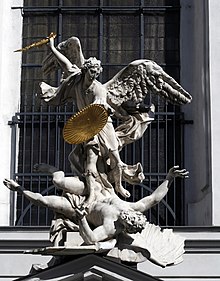Lorenzo Mattielli
Lorenzo Mattielli (or Lorenzo Matielli ) (* 1687 in Vicenza , Italy , † April 28, 1748 in Dresden ) was an Italian sculptor who worked mainly north of the Alps.
Life
The sculptor, born in Vicenza in 1687, is one of the most important Italian baroque artists who worked north of the Alps. After training with the sculptor Orazio Marinali (1643-1720), he worked from 1711 with the support of Wilhelmine Amalie von Braunschweig-Lüneburg , wife of Emperor Joseph I , for the court in Vienna , the Viennese nobility and the church.
Work in imperial Vienna
In Vienna he worked, among other things, on the sculptural furnishings of the Vienna Hofburg , "4 Works of Hercules" on the Reichskanzleitrakt in the courtyard, on the side portal reliefs in the city palace of Prince Eugene of Savoy , the Schwarzenberg palace , on the armory of the fire brigade on Am Hof square , the Karlskirche , in Thürnthal Castle and in the monasteries in Melk , Klosterneuburg and Mariazell .
In 1714 he was appointed imperial court sculptor .
The gable figure of St. Karl Borromeo at the Karlskirche in Vienna , the personifications of religion, mercy, penitentiality and zeal for prayer on the attic , as well as the angel figures on the drum , the crowning eagles on the large columns, the angels of the high altar and on the are from his hands Michaelerkirche the Engelssturzgruppe. One of his important collaborators was the young sculptor Johann Joseph Resler .
The imperial quarry
Lorenzo Mattielli mainly worked with the Zogelsdorfer Stein , then known as the Eggenburger Stein. During stone exploration, the limestone from Kaisersteinbruch could also be identified for sculptural work. A selection:
In 1737 he took part in the tender for the Providentiabrunnen on the Mehlmarkt (today Neuer Markt ), which was organized for the first time by the self-confident citizens of the city of Vienna, but the young Georg Raphael Donner received the contract .
Work in the electoral Dresden
In 1738 Mattielli was appointed “Commissioner for Ancient and Modern Statues” by Elector Friedrich August II in Dresden. In October 1739 he was the first royal court sculptor to be commissioned to make 78 larger-than-life statues for the Catholic court church , which are still on the building today.
During his time in Dresden he also worked from 1741 to 1746 in the baroque garden of the Palais Brühl-Marcolini on his main work, the Neptune Fountain , a 40-meter-wide, three-story fountain. Mattielli's workshop also created the staircase figures and fountains for the Palais Brühl , the Palais Moszyńska , the Hubertusburg hunting lodge and numerous other buildings.
Mattielli died in Dresden in 1748 and was buried in the Old Catholic Cemetery. His gravestone has not been preserved. Therefore, a memorial stele in the cemetery has been commemorating him since 2001.
In 1901, Mattiellistraße in Vienna- Wieden (4th district) was named after him.
literature
- Constantin von Wurzbach : Mattielli, also Mattiello, Lorenz . In: Biographisches Lexikon des Kaiserthums Oesterreich . 17th part. Imperial-Royal Court and State Printing Office, Vienna 1867, p. 119 f. ( Digitized version ).
- Richard Steche : Mattielli, Lorenzo . In: Allgemeine Deutsche Biographie (ADB). Volume 20, Duncker & Humblot, Leipzig 1884, p. 673 f.
- Ingeborg Schemper-Sparholz: Mattielli, Lorenzo. In: New German Biography (NDB). Volume 16, Duncker & Humblot, Berlin 1990, ISBN 3-428-00197-4 , p. 416 f. ( Digitized version ).
- Lorenzo Mattielli . In: Sieghart Pietzsch: Chronicle of Hosterwitz 1406-2006 . Elbhang-Kurier-Verlag, Dresden 2006, ISBN 3-936240-07-8 , p. 384.
Individual evidence
- ^ Helmuth Furch , Historisches Lexikon Kaisersteinbruch. Volume 2 I – Z, Index Mattielli Lorenzo, Elias Hill , Hercules statues, Hofburg, balconies; Portal reliefs Winter Palace Prinz Eugen. Museum and cultural association Kaisersteinbruch , Bruckneudorf-Kaisersteinbruch 2004.
- ^ Historical lexicon Kaisersteinbruch. Volume 2 I-Z. PDF.
Web links
- Literature by and about Lorenzo Mattielli in the catalog of the German National Library
- Entry on Lorenzo Mattielli in the database of the state's memory of the history of Lower Austria ( Museum Niederösterreich )
| personal data | |
|---|---|
| SURNAME | Mattielli, Lorenzo |
| ALTERNATIVE NAMES | Matielli, Lorenzo |
| BRIEF DESCRIPTION | Italian sculptor |
| DATE OF BIRTH | 1687 |
| PLACE OF BIRTH | Vicenza , Italy |
| DATE OF DEATH | April 28, 1748 |
| Place of death | Dresden |



